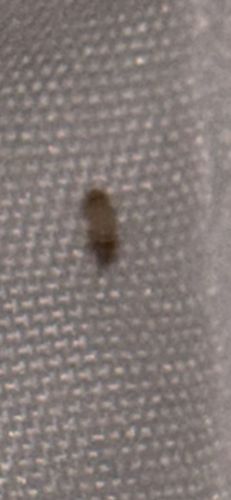Carpet Beetle (likely Varied Carpet Beetle or Black Carpet Beetle larva)
Scientific Name: Likely from the genera Anthrenus (e.g., Anthrenus verbasci for Varied Carpet Beetle) or Attagenus (e.g., Attagenus unicolor for Black Carpet Beetle)
Order & Family: Order: Coleoptera, Family: Dermestidae
Size: Larvae typically range from 2 mm to 5 mm (0.08 to 0.2 inches) in length. Adults are usually 2-4 mm (0.08 to 0.16 inches).

Natural Habitat
Indoors, carpet beetles are found in homes, museums, warehouses, and other buildings. They prefer dark, undisturbed areas such as under carpets, in closets, in attics, and behind baseboards. Outdoors, they can be found in bird nests, animal nests, and feeding on various plants.
Diet & Feeding
Larvae feed on a variety of organic materials, including wool, silk, feathers, leather, furs, pet hair, dead insects, dried meat, and natural fibers in carpets, clothing, and upholstered furniture. Adult carpet beetles feed on pollen and nectar.
Behavior Patterns
Carpet beetle larvae are typically found in dark, undisturbed areas where their food sources are abundant. They are slow-moving and tend to avoid light. Adults are attracted to light and often found near windows. They undergo complete metamorphosis: egg, larva, pupa, adult.
Risks & Benefits
Risks: Carpet beetle larvae can be significant pests, causing damage to natural fibers in clothing, carpets, upholstered furniture, and other household items containing animal products. They can also infest stored food products. Some people may experience skin irritation or allergic reactions due to contact with carpet beetle hairs. Benefits: In nature, they play a role in decomposition by feeding on dead organic matter.
Identified on: 8/25/2025